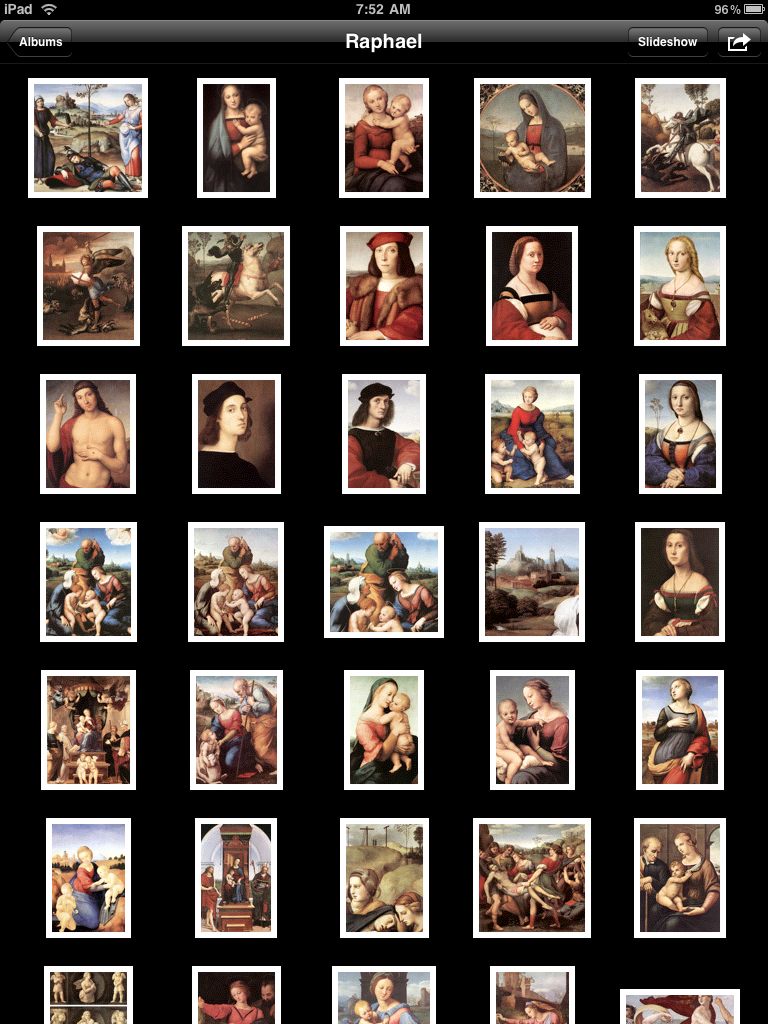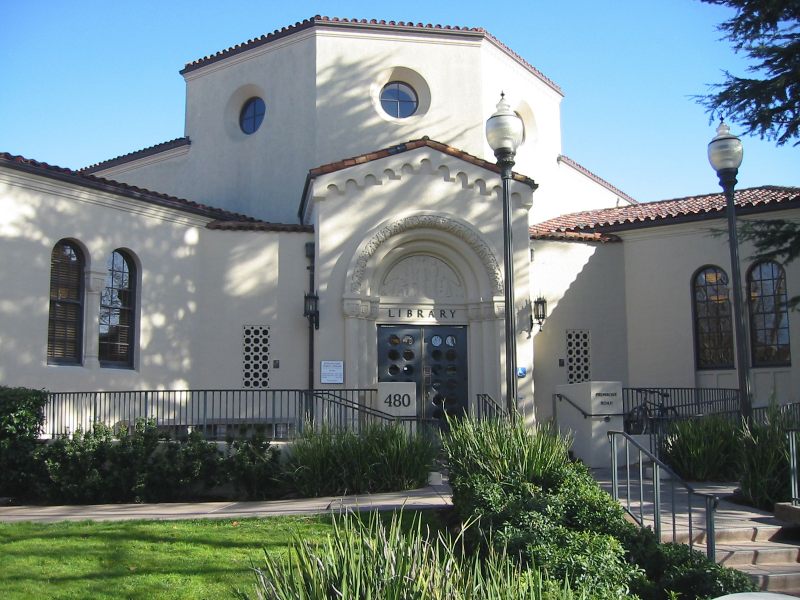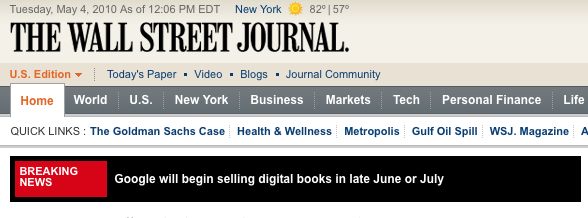Content conversion is the challenge.
The Beautiful Planet app for the iPad gives you some idea of the future of books. While the navigation is rudimentary, basically being limited to broad geographical locations and seemingly random order of content once you choose a location, it works well as it showcases great photography and the viewer doesn’t much care whether the photograph was taken in Montevideo or Moscow.
But that’s not an approach which will work well for most art books, be they about paintings or photography. Context and background information are required to make the book truly useful.
One of the finest books in my small collection is Raphael by Pierluigi De Vecchi and while the quality of the reproductions and writing are both splendid, it’s never lost on me that the book weighs in at over 8 pounds. It’s simply not comfortable to keep it in your hands or on your lap for any period of time. As a long time fan of the Italian master, I have always kept images of most of his works, sourced from Google Images, in iPhoto and would take these with me on my now defunct netbook when traveling. There’s nothing finer than relaxing with the Italian master’s work before settling in for a night of the dreamless, with iPhoto giving me the option of musical accompaniment of choice.
So it was a moment’s work to synch my Raphael collection with the iPad, and I threw in two other Renaissance masters, Titian and Caravaggio, for luck. This is how the album looks on the iPad:

And here’s a specimen full page view:

What is significant here is that the iPad’s weight remained unchanged at 1.5lbs …. and each album of 70-100 images consumes maybe 75mB of storage. So ten albums, which will get you most of the greatest western art ever painted, run under 1gB. Not a lot.
In addition to the weight (as in lack thereof) advantages, a computer screen is transilluminated, so a well processed original will have tremendous dynamic range – inky blacks and snowy whites. And unlike using a netbook or laptop, as long as the original has enough detail a simple unpinching motion with thumb and forefinger allows me to zoom in on Raphael’s brushwork to enjoy some favorite detail. What is sorely lacking is context. While I have no particular need of the detailed narrative presented in the original book, what I would really like is some sort of index, and the ability to touch a painting on the screen ane be told about its history, location, etc. But given the slow moving art world, the myriad of complications regarding licensing and reproduction rights and so on, I’m not holding my breath. It will be ages, I suspect, before art books take advantage of the magical properties of touchscreen technology.
Further, it is obviously unlikely that the couple of hundred books of photographs I own will ever be converted to digital files. Most are out of print and one of the quickest ways I can think of losing money is to publish photography books.
So it’s time to take the law into your own hands, and remove the book from them at the same time, if you get my drift.
Mercifully Rube Goldberg lives, in the guise of a gadget named the Scan Robot made by some foresightful inventors in Germany and pointed out to me by fellow iPad owner and blog reader, Gregg L. Thank you, Gregg!
You can watch the hypnotic video by clicking below. The maker, Treventus, claims 25 pages per minute can be scanned, though I have yet to find out what the dpi resolution is.
I have no doubt that the device is anything but cheap, but once some smart person at HP or Epson twigs the market potential, we should see high volume production take the price down to the $1-2,000 range. Some other smart person will go into the leasing business and this consumer will be first in line for a lease, after which all my books will be in digital format. Let’s see – 250 books, 50,000 pages, 35 hours, $10 per hour for the student working the thing, $500 to lease it … and a $10,000 tax deduction when I give all the originals to the local library. That solves.
Now let me take this thinking further. My local library, the Burlingame Public Library, occupies a gorgeous building on the prime acre of real estate in the town of Burlingame in Northern California.
I would estimate the value of the lot to be $100 million. It houses 216,579 books with a replacement cost of, say, $5 million. So after sale, the city is left with $95 million and the taxpayer is relieved of the tax cost of probably 50 employees who will now be required to find jobs in the for profit sector. A win-win. What about that $95 million left over? Well, I would guess that the Burlingame Public Library has no more than 5,000 regular visitors and seemingly 20% of those are bums looking for a warm place to hang out during the day. The cost of a tablet computer for each member is $3 million and digitization of the library’s contents is, at say $5 a book, another $5 million. Yes, that’s right. Give every member a tablet computer at the taxpayer’s cost – it saves money net, which is the name of the game. Heck, go crazy and give every one of Burlingame’s 25,000 residents a tablet computer. Cost? A mere $12 million.

The Burlingame Public Library. Prime real estate, awaiting development.
Bottom line?
- The City has $80 million left over which it can steal for other useless purposes or, God forbid, return to its taxpayers.
- Apple’s iPad sales go up by 25,000 for this one library alone and you and I make money on the stock
- All those new iPad users now have real incentive to ‘visit the library’ and, in true American fashion, will have no need to get off their burgeoning behinds
- $5 million of unproductive payroll and overhead is removed from the tax bill
- Developers redevelop the site for a for profit business (likely as not a larger Apple Store to handle the increased demand) and the tax base expands accordingly
- Natural resource use plummets from all those saved 1 mile drives to the library. Air quality improves. Traffic falls. Road repair costs drop. Accidents and police costs fall.
- Schoolchildren have online access to a vastly expanded library
- Repeat for all those libraries – starting with the one on Fifth Avenue in New York which would make for some nice high end condominiums – and you begin to eat into that budget deficit. I figure that one would easily raise $3 billion for the city block on which it sits.
And, yes, the chances of any of this happening in my lifetime are zero.
But the art book’s future is clear and when the 21″ iPad comes along I propose to be one of the first to have all my art books on it. Along with the hundreds of DVDs and CDs I converted years ago.
Of course, I hope the Burlingame Public Library is still around then, as I will need the tax deduction from the gift I will be making of my whole collection. It’s not like I’m about to end up out of pocket on this little venture now, is it?
Still, it seems I’m not the only one who gets it:
